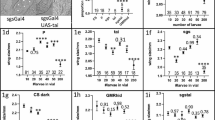Abstract
The effect of rearing conditions for gypsy moth larvae on parameters of their development (its duration and mortality) was studied in experiments with early instar larvae reared singly or in groups. The manifestation of the group effect was analyzed depending on the choice of experimental unit (the larva or the rearing container) and the amount of volume per larva. The observed effects were evaluated quantitatively.
Similar content being viewed by others
References
Grassé, P.P. and Chauvin, R., L’effet de groupe et la survie des neutres dans les sociétés d’insectes, Rev. Sci., 1944, vol. 82, pp. 461–464.
Wilson, E.O., Sociobiology: The New Synthesis, Cambridge, MA: Harvard Univ. Press, 1975.
Zakhvatkin, Yu.A. and Isaichev, V.V., Slovar’-spravochnik entomologa (Entomologist’s Handbook and Dictionary), Moscow: Niva Rossii, 1992.
Preiss, R., Flight-phase and visual-field related optomotor yaw responses in gregarious desert locusts during tethered flight, J. Comp. Physiol. A, 1993, no. 127, pp. 733–740.
Lihoreau, M. and Rivault, C., Tactile stimuli trigger group effects in cockroach aggregations, Anim. Behav., 2008, no. 75, pp. 1965–1972.
Wyatt, T.D., Pheromones and Animal Behaviour: Communication by Smell and Taste, Cambridge: Cambridge Univ. Press, 2003.
Vasil’eva, T.G., Studies on the group effect in gypsy moth, in Neparnyi shelkopryad v Srednei i Vostochnoi Sibiri (Gypsy Moth in Central and Eastern Siberia), Novosibirsk: Nauka, 1982, pp. 51–58.
Zlotin, A.Z., Effect of density and chemical treatment of food on the development of Ocneria dispar L. reared under laboratory conditions, Zool. Zh., 1965, vol. 44, no. 12, pp. 1809–1812.
Kireeva, I.M., Ekologiya i fiziologiya neparnogo shelkopryada (The Ecology and Physiology of Gypsy Moth), Kiev: Naukova Dumka, 1983.
Kozlov, M.V., Planirovanie ekologicheskikh issledovanii: teoriya i prakticheskie rekomendatsii (Ecological Research Planning: Theory and Practical Guidelines), Moscow: KMK, 2014.
Il'inykh, A.V., Optimized artificial medium for gypsy moth (Ocneria dispar L.) rearing, Biotekhnologiya, 1996, no. 7, pp. 42–43.
Ponomarev, V.I., Shatalin, N.V., and Strel’skaya, T.M., Effect of Fe3+ ions added to food on manifestation of group effect in gypsy moth larvae (Lymantria dispar L.), Izv. S.-Peterb. Lesotekh. Akad., St. Petersburg, 2009, no. 187, pp. 249–258.
Mallows, C.L., Some comments on Cp, Technometrics, 1973, vol. 15, no. 4, pp. 661–675.
Hurlbert, S.H., Pseudoreplication and the design of ecological field experiments, Ecol. Monogr., 1984, vol. 54, pp. 187–211.
Oksanen, L., Logic of experiments in ecology: Is pseudoreplication a pseudoissue?, Oikos, 2001, vol. 94, pp. 27–38.
Mason, C.J., Cannizzo, Z., and Raffa, K.F., Influence of diet and density on laboratory cannibalism behaviors in gypsy moth larvae (Lymantria dispar L.), J. Insect Behav., 2014, vol. 27, pp. 693–700.
Konikov, A.S., Regulyatory chislennosti lesnykh nasekomykh (Regulators of Forest Insect Abundance), Novosibirsk, 1978.
Baranchikov, Yu.N. and Vshivkova, T.A., Density effects in gypsy moth ontogeny, in Bolezni i vrediteli v lesakh Rossii: vek XXI: Mat-ly. Vseross. konf. s mezhdunar. uchastiem i V ezhegodnykh chtenii pamyati O.A. Kataeva (Diseases and Pests of Russian Forests in the 21st Century: Proc. All-Russia Conf. with International Participation and 5th Annual Lectures in Memory of O.A. Kataev), Krasnoyarsk: Inst. Lesa Sib. Otd. Ross. Akad. Nauk, 2011, pp. 107–109.
Author information
Authors and Affiliations
Corresponding author
Additional information
Original Russian Text © V.I. Ponomarev, G.I. Klobukov, V.V. Napalkova, I.A. Kshnyasev, 2017, published in Ekologiya, 2017, No. 4, pp. 304–311.
Rights and permissions
About this article
Cite this article
Ponomarev, V.I., Klobukov, G.I., Napalkova, V.V. et al. Influence of experimental conditions on manifestation of the group effect in the gypsy moth, Lymantria dispar L.. Russ J Ecol 48, 377–383 (2017). https://doi.org/10.1134/S1067413617040129
Received:
Published:
Issue Date:
DOI: https://doi.org/10.1134/S1067413617040129




